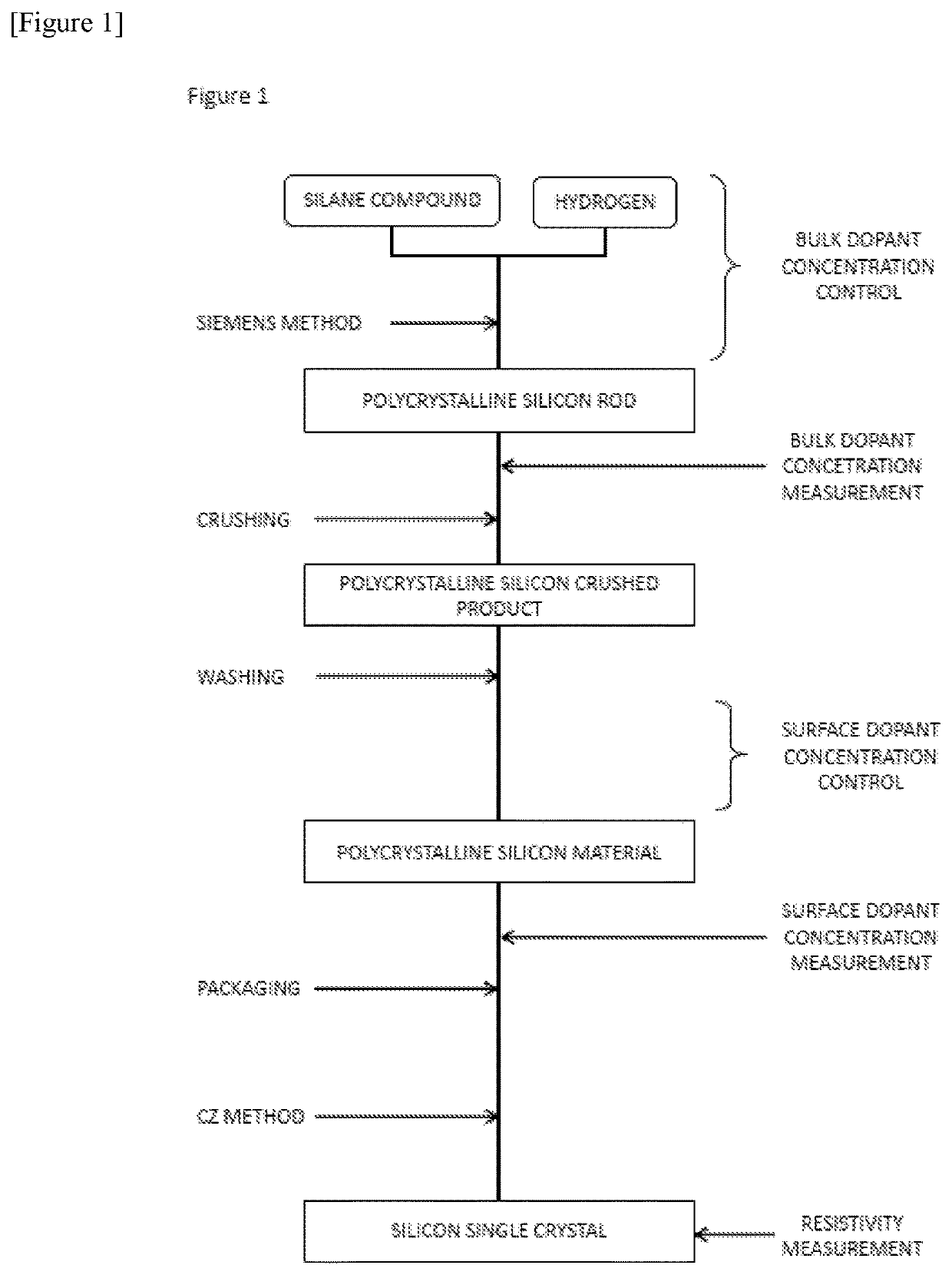Polycrystalline Silicon Material
- Summary
- Abstract
- Description
- Claims
- Application Information
AI Technical Summary
Benefits of technology
Problems solved by technology
Method used
Image
Examples
example 1
[0137]The polycrystalline silicon material was produced by the Siemens method. As the raw material gas, high-purity purified trichlorosilane and hydrogen were used.
[0138]Purified trichlorosilane produced by the method shown below was used. First, low-purity crude trichlorosilane was obtained by a reaction of metallurgical low-purity silicon called metallic silicon with hydrogen chloride and a reaction of the metallic silicon with tetrachlorosilane and hydrogen.
[0139]B, Al, P, and As were included in the metallic silicon being a raw material of the crude trichlorosilane at ratios of several hundred ppb to several hundred ppm. During the reaction of the metallic silicon with hydrogen chloride and the reaction of the metallic silicon with tetrachlorosilane and hydrogen, each dopant component was chlorinated and get into the crude trichlorosilane.
[0140]Therefore, the obtained crude trichlorosilane was distilled and purified to separate and remove B, P, Al, and As in the crude trichloros...
example 2
[0177]The synthesis, distillation and purification, recovery and purification of trichlorosilane, and the precipitation of polycrystalline silicon were carried out in a similar manner to Example 1. The concentration of dichlorosilane in the recovered purified trichlorosilane in this case was measured by gas chromatography and, as a result, was found to be 600 ppmw.
[0178]The polycrystalline silicon obtained after the precipitation was analyzed by the same method as in Example 1. The average resistivity was 3,100 [Ωcm]. The bulk B concentration was 2 [ppta], and the bulk Al concentration was less than 1 [ppta], which was the lower limit of quantification. The bulk acceptor concentration was set to 2 [ppta], regarding the bulk Al concentration as 0 [ppta]. The bulk P concentration was 31 [ppta] and the bulk As concentration was 2 [ppta]. Therefore, the bulk donor concentration was 33 [ppta].
[0179]Subsequently, in the same manner as in Example 1, the obtained polycrystalline silicon rod...
example 3
[0188]The synthesis, distillation and purification, recovery and purification of trichlorosilane, and the precipitation of polycrystalline silicon were carried out in a similar manner to Example 1. The concentration of dichlorosilane in the recovered purified trichlorosilane in this case was measured by gas chromatography and, as a result, was found to be 350 ppmw.
[0189]The polycrystalline silicon obtained after the precipitation was analyzed by the same method as in Example 1. The average resistivity was 5,300 [Ωcm]. The bulk B concentration was 2 [ppta], and the bulk Al concentration was less than 1 [ppta], which was the lower limit of quantification. The bulk acceptor concentration was set to 2 [ppta], regarding the bulk Al concentration as 0 [ppta]. The bulk P concentration was 17 [ppta] and the bulk As concentration was 2 [ppta]. Therefore, the bulk donor concentration was 19 [ppta].
[0190]Subsequently, in the same manner as in Example 1, the obtained polycrystalline silicon rod...
PUM
 Login to View More
Login to View More Abstract
Description
Claims
Application Information
 Login to View More
Login to View More - R&D
- Intellectual Property
- Life Sciences
- Materials
- Tech Scout
- Unparalleled Data Quality
- Higher Quality Content
- 60% Fewer Hallucinations
Browse by: Latest US Patents, China's latest patents, Technical Efficacy Thesaurus, Application Domain, Technology Topic, Popular Technical Reports.
© 2025 PatSnap. All rights reserved.Legal|Privacy policy|Modern Slavery Act Transparency Statement|Sitemap|About US| Contact US: help@patsnap.com

